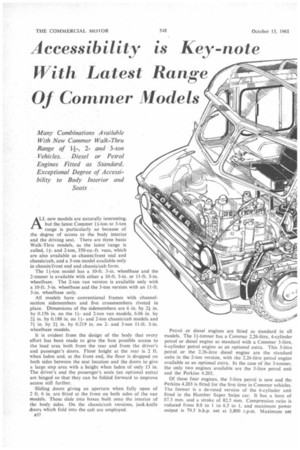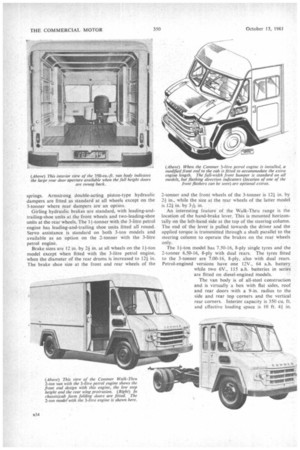Accessibility is Key-note With Latest Range Of Commer Models
Page 66

Page 67

Page 68

Page 69

If you've noticed an error in this article please click here to report it so we can fix it.
ALL new models are naturally interesting, but the latest Commer If-ton to 3-ton range is particularly so because of the degree of access to the body interior and the driving seat. There are three basic Walk-Thru models, as the latest range is called, 1+and 2-ton, 350-cu.-ft. vans, which are also available as chassis/front end and chassis/cab, and a 3-ton model available only in chassis/front end and chassis/cab form.
The II-ton model has a 10-ft. 3-in, wheelbase and the 2-tonner is available with either a 10-ft. 3-in. or II-ft. 3-in. wheelbase. The 2-ton van version is available only with a 10-ft. 3-in, wheelbase and the 3-ton version with an 11-ft.
3-in, wheelbase only. ,
All models have conventional frames with channelsection sidemembers and five crossmembers riveted in place. Dimensions of the sidemembers are 6 in. by 21 in. by 0.156 in. on the 11and 2-ton van models, 6.06 in. by 24 in. by 0.188 in. on 14and 2-ton chassis/cab models and 74 in. by 21 in. by 0.219 in. on 2and 3-ton 11-ft. 3-in. wheelbase -models.
It is evident from the design of the body that every effort has been made to give the best possible access to the load area both from the rear and from the driver's and passenger's doors. Floor height at the rear is 2 ft. when laden and, at the front end, the floor is dropped on both sides between the seat location and the doors to give a large step area with a height when laden of only 13 in. The driver's and the passenger's seats (an optional extra) are hinged so that they can be folded forward to improve access still further.
Sliding doors giving an aperture when fully open of 2 ft. 6 in. are fitted at the front on both sides of the van models. These slide into boxes built onto the interior of the body sides. On the chassis/cab versions, jack-knife doors which fold into the cab are employed.
B32 Petrol or diesel engines are fitted as standard in all models. The 1 f-tonner has a Commer 2.26-litre, 4-cylinder petrol or diesel engine as standard with a Commer 3-litre, 6-cylinder petrol engine as an optional extra. This 3-litre petrol or the 2.26-litre diesel engine are the standard units in the 2-ton version, with the 2.26-litre petrol engine available as an optional extra. In the case of the 3-tonner, the only two engines available are the 3-litre petrol unit and the Perkins 4.203.
Of these four engines, the 3-litre petrol is new and the Perkins 4.203 is fitted for the first time in Commer vehicles. The former is a de-rated version of the 6-cylinder unit fitted in the Humber Super Snipe car. It has a bore of 87.3 mm. and a stroke of 82.5 mm. Compression ratio is reduced from 8.0 to 1 to 6.5 to 1, and maximum power output is 79.5 b.h.p. net at 3,800 r.p.m. Maximum net torque is 145 lb.-ft. at 1,500 r.p.m., compared with 121 b.h.p. at 4,800 r.p.m. and 161.6 lb.-ft. at 1,800 r.p.m., respectively, for the engine fitted in the Super Snipe.
Twin rocker mechanisms operate separately the banks of inlet and exhaust valves which have their manifolds on opposite sides of the engine.
The Perkins 4.203 is a 4-cylindered indirect-injection unit with a bore of 91.44 mm. and a stroke of 127 mm. Capacity is 3.331 litres (203.5 Cu. in.) and maximum net output is 57 b.h.p. at 2,600 r.p.m. Maximum torque is 142 lb.-ft. at 1,350 r.p.m.
Both the 2.26-litre engines are identical, except for minor alterations, with units already fitted in Commer vehicles. The petrol engine is currently used in the Commer 1and 11-ton vans, which are not replaced by the Walk-Thru range. The unit has a maximum net output of 52.5 b.h.p. at 3,400 r.p.m. and maximum torque of 104 lb.-ft. at 1,600 r.p.m. The diesel engine also has a maximum net output of 52.5 b.h.p., but at a lower engine speed of 3,000 r.p.m. Maximum torque is a little lower than that of the petrol unit-100 lb.-ft. at 1,750 r.p.m. Both engines can be supplied with chromium-plated cylinder bores as an optional extra. Borg and Beck single-dry-plate clutches having ball-type release bearings are fitted to each of the four engines. The 2.26-litre diesel, the Perkins 4.203 diesel and the 3-litre petrol engines have clutches of 10-in, diameter, while a 9-in, diameter clutch is fitted to the 2.26-litre petrol unit.
Transmission on all models is through a four-speed forward and reverse gearbox, with synchromesh on the three higher ratios. Gear ratios are 5.77, 3.029, 1.703 and 1 to I. Reverse gear ratio is 6.985 to I. All models also have a fully-floating spiral-bevel rear axle. The standard ratio on the 1 konner is 5.57 to 1 with the 2.26-litre petrol or diesel engine and 5.43 to 1 when the 3-litre petrol engine is fitted. With the larger engine an optional 6.0-to-1 ratio can be fitted if required.
Each of the other models in the range has standard and optional ratios dependent on the engine fitted. On the 2-tonner, the standard ratio with the 3-litre petrol engine is 5.43 to 1 and with the 2.26-litre petrol and diesel engines, 6.0 to 1. Optional ratios are 6.0, 6.57 and 5.43 to 1, respectively. When the 3-litre petrol engine is fitted in the 3-tonner, the 6.0-to-1 ratio is standard with the 6.57-to-1 ratio optional. With the Perkins 4.203, the standard is 4.87 to 1 with 5.43 to 1 available as an optional extra.
Suspension on all models is through semi-elliptic leaf a33
springs. Armstrong double-acting piston-type hydraulic dampers are fitted as standard at all wheels except on the 3-tonner where rear dampers are an option.
Girling hydraulic brakes are standard, with leading-andtrailing-shoe units at the front wheels and two-leading-shoe units at the rear wheels. The 14--tonner with the 3-litre petrol engine has leading-and-trailing shoe units fitted all round. Servo assistance is standard on both 3-ton models and available as an option on the 2-tonner with the 3-litre petrol engine.
Brake sizes are 12 in. by 2+ in. at all wheels on the li-ton model except when fitted with the 3-litre petrol engine, when the diameter of the rear drums is increased to 12+ in. The brake shoe size at the front and rear wheels of the
2-tonner and the front wheels of the 3-tonner is 12+ in. by 2+ in., while the size at the rear wheels of the latter model is 121 in. by 3-11,-, in.
An interesting feature of the Walk-Thru range is the location of the hand-brake lever. This is mounted horizontally on the left-hand side at the top of the steering column. The end of the lever is pulled towards the driver and the applied torque is transmitted through a shaft parallel to the steering column to operate the brakes on the rear wheels only.
The 1+-ton model has 7.50-16, 8-ply single tyres and the 2-tonner 6.50-16, 8-ply with dual rears. The tyres fitted to the 3-tonner are 7.00-16, 8-ply, also with dual rears. Petrol-engined versions have one 12V., 64 a.h. battery while two 6V., 115 a.h. batteries in series are fitted on diesel-engined models.
The van body is of all-steel construction and is virtually a box with flat sides, roof and rear doors with a 9-in, radius to the side and rear top corners and the vertical rear corners. Interior capacity is 350 Cu. ft. and effective loading space is 10 ft. 41 in. long and 6 ft. Li in. wide. Width between door boxes is 5 ft. 61 in. and between the square wheelboxes 3 ft. 6 in. Height at the centre of the body is 5 ft. 91 in. Rear door aperture is almost square, measuring 5 ft. 2 in. high by 5 ft. 3 in. wide.
The body floor is of hardwood, supported in steel longitudinals which overlap the timber to give a flat surface. Full height double rear doors are fitted each having a
glazed panel hung on special cast hinges, which allow them to open through 2600 to lie back against the body sides when fully open. In this position they are held by selfreleasing catches. An external locking handle is fitted to the offside doors, internal handles are fitted to both and they are sealed all round with rubber.
Nylon striking plates are fitted for the top and bottom door catches. These are adjustable and have angled faces which mate with the top and bottom edges of the doors so that door rattles are overcome. Strong rear quarter bumpers are available as an extra and there is also a dropped centre section which can be obtained as an extra for fitting between them to make a step.
Metal-faced timber rubbing strips are positioned on both sides of the body and apart from these the sides on the 11-ton van are completely flat. On the 2-tonner, however, the fitting of twin rear wheels necessitates shallow rear wings. On both models the fuel tank filler also protrudes from the body slightly on the nearside just in front of the rear wheel.
Visibility on the Walk-Thru range appears to be good. The full-width, two-piece windscreen has a good depth and, in addition to quarter lights, 'there are small windows beneath them on both sides of the cab. On the vans the sliding doors have large windows, but on the chassis/cab versions with folding doors, visibility to the side is limited by the solid section between the narrow windows.
Ventilation is helped by fresh air vents in the interior panels on both sides below the windscreen, and by the front halves of the door windows sliding back. Single or twin heating and demisting equipment can be fitted as an extra in place of the fresh air vents.
Other standard fittings are interior lights above the windscreen on the van models, and twin windscreen wipers on all models. Flashing direction indicators are also available as optional extras.




































































































































